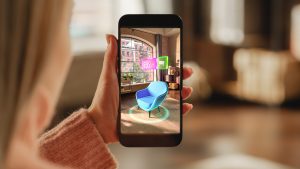By Ellie-Rose Davies, Content Executive at IMRG
In this blog we will be reflecting on the value of omnichannel retail, exploring key areas such as incentivising retention through online and offline loyalty programmes, and optimising returns to bring online customers in store.
We will also share strategies to bring the in-store experience online, focussing on creating immersive experiences to replicate in-store interactions online, and enhancing assistance and communication through offering in-store levels of customer service online.
Read on to hear from industry experts who have provided examples of retailers who have excellent omnichannel strategies and who have shared tips for best practices.
Why are retailers prioritising omnichannel strategies?
Omnichannel retail incentivises loyalty
Loyalty is hard-earned and easily lost. IMRG research shows that just 1-2 negative experience can deter 53.2% of customers from shopping with their favourite retailer. To prevent this, it’s crucial to provide consistently positive interactions both online and in-store, which is where an omnichannel strategy plays a vital role.
Georgia Leybourne, CMO at Linnworks, highlights that, ‘Omnichannel retail strategies create a seamless customer experience across online and offline channels. By integrating these channels, retailers can offer services like buy online, pick up in-store (BOPIS), enhancing convenience and driving foot traffic.’
She also notes how ‘Online channels provide valuable data on customer preferences for personalised in-store experiences, while in-store interactions boost online engagement through loyalty programs and exclusive offers. Retailers with strong omnichannel strategies retain 89% of their customers, compared to 33% for those with weak strategies.’
Dan, VP of Marketing at RevLifter suggests that driving customers in-store can bring substantial benefits; ‘Retailers who drive people in-store enjoy great benefits, including lower operational costs, more control of the customer experience, and opportunities for cross-selling.’
He adds, ‘Incentivising in-store experiences can significantly enhance customer engagement and drive foot traffic. One effective strategy is to offer exclusive online discounts or rewards for customers who visit physical stores. For instance, a “Click & Collect” option paired with in-store promotions can encourage online shoppers to experience products firsthand.’
‘Implementing loyalty programs that reward customers for online purchases and in-store visits fosters a sense of community,’ says Dan, ‘encouraging repeat visits and interactions while enhancing overall customer satisfaction.’
Omnichannel retail can drive positive post-purchase results i.e. with returns
Returns are an essential aspect of omnichannel retail and can similarly increase footfall in physical stores.
Sean Sherwin Smith, Product Director Post-Purchase at nShift, shares that, ‘Hunkemöller, Europe’s fastest-growing lingerie specialist, has seen a 15% spike in sales by shifting its online to warehouse returns towards in-store. This approach not only strengthens customer relationships but also creates new remarketing and repurchase opportunities.’
He continues, ‘To deliver a flawless and connected omnichannel customer journey that inspires through exceptional delivery standards and cultivates customer loyalty, retailers need close, effective collaboration between logistics functions, in charge of the last mile, and ecommerce teams, who oversee the customer experience.’
Nikhita Hyett, General Manager EMEA at Signifyd, explains, ‘We talk about the importance of providing “the Amazon Experience”, but until now, this has focused mainly on CX until checkout. Today, more than ever, the online retail experience goes beyond this to include the return process.’
‘Retailers can provide smooth and buyer-friendly experiences through the full shopping lifecycle, as evidenced by our research, which found a direct link in how return policies drive consumer buying decisions: 94% of European consumers find it a crucial factor when buying, with 50% or more deciding whether to shop with a retailer based on their policies.’
How can retailers create the in-store ‘feeling’ online?
Immersive experiences that make online retail feel more ‘real’
Retailers are increasingly focused on bridging the gap between in-store and online experiences to foster growth and engagement.
Kobi Schwarts, VP of Channel Sales & Partner Enablement at Cloudinary states, ‘Bridging the gap between in-store and online experiences is essential for growth.

Retailers like Guess have effectively leveraged omnichannel strategies, integrating high-quality visual assets across stores, web, and mobile to enhance the shopping experience.’
He continues, ‘Optimising product displays with tools like AI-driven image and video API platforms can significantly boost engagement and accessibility. The key is to ensure each channel complements the other, creating a seamless, interactive experience. Embracing a composable tech stack empowers retailers to quickly adapt to changing consumer behaviours while delivering a consistent, dynamic presence across all platforms.’
Matthew Trattles from ShipStation highlights the importance of recreating in-store magic online through immersive experiences. He notes, ‘To recreate in-store magic online, retailers can go beyond static product pages and prioritise interactive product displays, personalisation, and seamless channel integration. Think 360-degree views, AR try-ons, virtual showrooms, and AI-powered recommendations based on browsing behaviour. These elements not only replicate the experience of a physical store but also create a sense of discovery and excitement that keeps customers engaged.’
Matthew adds, ‘A ShipStation study revealed that a striking 77% of British consumers switch between online and in-store channels during their shopping journey, highlighting the urgency for retailers to adopt an omnichannel approach. Take inspiration from brands who excel at blending the online and offline worlds through virtual consultations, in-store events tied to online campaigns, and immersive flagship store experiences.’
Offering in-store level assistance and communication

Customers value in-store shopping for the immediate assistance available, which is often missing online. To overcome this, retailers can enhance their digital experiences with real-time help and personalised support.
Pete Robertshaw, Head of eCommerce Consultancy at Dark Matter Commerce, shares how.
‘Tools like GoInStore or ConferWith, which offer portable video live chat, enable customers to communicate with in-store team members, enhancing the shopping experience,’ shares Pete.
He points out, ‘In the absence of in-store assistance, online quizzes and product recommendations, particularly when informed by in-store sales expertise, can guide customers effectively. Online platforms also have the advantage of leveraging data to personalise shopping journeys, particularly for repeat purchases.’
An extra tip provided by Pete is for retailers to ‘incorporate low-cost, impulse-buy items in the checkout process, similar to in-store practices, which can drive additional sales and help customers reach thresholds like free delivery.’
Gavin Murphy, CMO at Scurri, offers insight into The Perfume Shop’s approach, where the in-store experience complements the online experience. ‘The Perfume Shop, a Scurri brand partner, delivers a true omnichannel experience despite offering a product not traditionally associated with online purchasing. Innovations like the Fragrance Finder tool and live online chats with in-store experts bridge the gap between the physical and digital realms, providing customers with guidance and confidence.’
Gavin further explains, ‘This not only improves customer experience in digital shopping journeys, but it also helps bridge the gap between The Perfume Shop’s channels and provide confidence when buying a product traditionally only associated with a physical test and try experience.’
‘Additionally, the seasonal nature of its products creates huge delivery demand spikes around key gifting dates in the year, meaning the business must build agility and scalability into its operations to continue to deliver customer experience to shoppers.’
Gavin recommends, ‘Innovations like “ship from store” so customers experience faster delivery, therefore allowing the retailer to live up to its brand promise while also maximising sellable inventory. Approximately 18% of The Perfume Shop’s online orders are now shipped from store.’
Bill Schneider, VP of Product Marketing at SheerID, also notes the importance of blending in-store service levels online. He says, ‘The in-store experience is highly valued by customers because of the level of service and connection they have with store associates in an in-store environment. Digital naturally provides the benefit of immediacy, but service in the browsing and education experience can be lacking.’
Bill comments, ‘To merge the two, brands are investing in interactive experiences like interactive quizzes, product finders, chat bots and gated, exclusive offers. These experiences allow retailers to learn more about who the customer is and what they are interested in, helping retailers power unique content. Gated offers are a great way to learn who the customer is and demonstrate how valued they are.’
By refining omnichannel strategies, retailers can deliver exceptional customer experiences that seamlessly integrates all channels, driving loyalty and boosting profitability.
Want to read more? Here are some other IMRG blogs that cover a range of eCommerce topics:
Join The Responsible Consumption Revolution – IMRG
Why Multichannel Retail Is Essential For Success In 2024 – IMRG
Ecommerce for Niche Markets: Strategies and Success Stories – IMRG
Mastering Mobile Commerce: Enhancing Apps, UX, and Conversion Strategies – IMRG
Top 11 Commerce Trends For Retailers In 2024 – IMRG
Published 05/09/2023


